Medieval period and Turkish reign
The evidence of prisons in feudal Serbia can be found in the monastery chrysocolla (Chrysobulls of Saint George of Skopje from 1299, Chrysobulls of Saint Stephen from 1313, Archangel’s Chrysobulls from 1348), which mention “dungeon” together with corporal punishments and the death penalty. Dushan’s Code from 1349 was familiar with several types of deprivation of liberty, including state, church and noblemen’s dungeons and the dungeon of the imperial court. According to Dushan’s Code, a dungeon for an indefinite period could be imposed on “monk who abandons the habit” and “drunkards”. Deprivation of liberty also appears as a measure against the accused and debtors. During the Turkish reign, previous laws were abolished, and disputes were solved following customary law.
The period from the deliberation from the Turkish reign until World War I
During the deliberation of the Turkish reign, new legal provisions were adopted and applied to deliberated territories. Karađorđe’s Criminal Code from 1807 was familiar with imprisonment, or “arrest” for minor offences. An arrest could be imposed with other punishments, such as corporal, but the convicted person could be kept under arrest after the execution of corporal punishment until the damage was compensated.
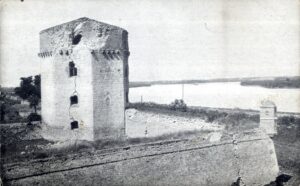
Photography 1. View of Nebojša’s Tower in Belgrade, which served as a prison during the Turkish reign.
Source: https://digitalna.nb.rs/view/URN:NB:RS:SD_F0CEC658F0854DA35C1559F2F5E00168
Army Law from 1839. was familiar with imprisonment and imprisonment with hard labor until one year (severe punishments) and “severe dungeon” and “imprisonment with hard labor until five years” (the most severe punishments). The Organization of District Courts from 1840 distinguished: imprisonment with hard labor (lifetime or temporary with or without chains), dungeon (lifetime or temporary), and prison (public or domestic).
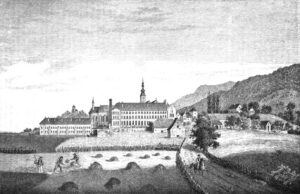
Photography 2. Penitentiary in Lepoglava was established in 1855, during Austrian reign, and expanded in 1913 and 1914, before World War I, when a new modern prison building was made.
Source: https://upload.wikimedia.org/wikipedia/commons/4/4a/Lepoglava_1880_F._Kikerec.jpg
Criminal Code of Principality of Serbia from 1860 prescribed imprisonment with hard labor and a dungeon for crimes (more serious offenses) and prison for less serious offenses. These punishments were executed in joint penitentiaries, where the convicts were classified only by gender. The perpetrators of more serious offenses (banditry, setting a fire, and brigandage) were not only deprived of liberty but also put in chains and forced to hard labor. Dungeon was a less severe punishment than imprisonment with hard labor, and it was imposed on political delinquents. It was executed in special prisons or departments of penitentiaries, and persons convicted in the dungeon were not forced to work and were allowed to wear their own clothes and buy their own food.
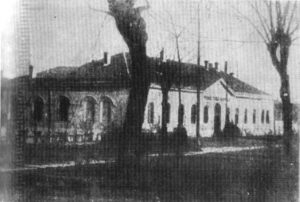
Photography 3. The building of the Administration of the City of Belgrade was built around 1864. In its basement, a prison named Glavnjača was placed.
Source: https://commons.wikimedia.org/wiki/File:Glavnja%C4%8Da.jpg
Imprisonment in Serbia in that period was criticized by the authors of the new Project of Serbian Criminal Code from 1910. They pointed out that the punishment of imprisonment and imprisonment with hard labor was not executed following any system, as well as that there was no difference between them. They also stated that the persons sentenced to imprisonment with hard labor and those sentenced to prison served their sentences together, whereas juvenile offenders were placed with adults. They highlighted that convicted persons did not have any working engagements and that there was no progress in their re-education. Convicts were often released before serving their sentences because penitentiaries were overcrowded. The Project of the new Criminal Code prescribed the introduction of a progressive system of imprisonment execution in Serbia, but it never came into force. Due to the lack of a comprehensive legal document, there were several different penal systems in Serbia until the end of World War I.
In prisons in Niš, Skoplje, Požarevac, and Podgorica the system of joint imprisonment was applied, whereas penitentiaries in Lepoglava, Stara Gradiška, Sremska Mitrovica, and Zenica had an Irish progressive system.
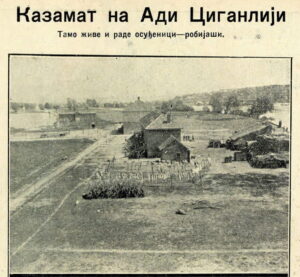
Photography 4. View of Prison at Ada Ciganlija in Belgrade, which functioned between 1920 and 1954. This photograph was published in newspapers in 1929. Source: https://kaldrma.rs/sing-sing-na-cukarici/
The period between World War I and World War II
After the establishment of the Kingdom of Serbs, Croatians, Slovenians, and the Kingdom of Yugoslavia, the preparation of the new Criminal Code started, which was adopted in 1929. So, from 1930, when this code and Law on the Enforcement of Deprivation of Liberty came into force, a unified system of criminal law was introduced, which was in force until 1941. The punishments of deprivation of liberty were imprisonment with hard labor and a dungeon, they were executed following the rules of the Irish progressive system and the classification of convicts was implemented depending on type and length of punishment, gender, age, and personal characteristics. Their treatment depended on the type of deprivation of liberty, as well as on their personal characteristics. Convicts’ labor was obligatory, with the option to choose the type of labor depending on their capabilities and affinities. Juvenile penitentiaries were obliged to provide convicts with education and juveniles’ labor had to be adjusted to their physical and mental capabilities.
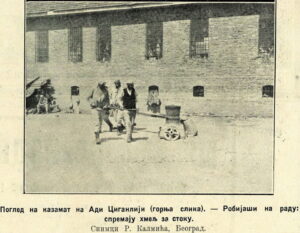
Photography 5. A detail from everyday life in prison at Ada Ciganlija in Belgrade, which functioned between 1920 and 1954. This photograph was published in newspapers in 1929.
Source: https://kaldrma.rs/sing-sing-na-cukarici/
The period of National Liberation Struggle and post-World War II
During the National Liberation Struggle and post-World War II, a new legal system of a newly established state was formed. Law on the Types of Punishments from 1945 was familiar with deprivation of liberty with or without obligatory labor. This field was arranged in detail by Temporary Instruction for the enforcement of punishments from 1945, which refers to penal institutions as penal and educational institutions for the first time. That is the period when the ideas of re-education, a joint serving of prison sentences, and classification of convicts were accepted. The Bylaw regulating behavior in penal and educational institutions and district and county prisons was adopted in 1947 and it referred to the most important issues from this field. The Bylaw prescribed the purpose of the execution of punishment, focusing on re-education and preparation for a purposeful life.
Law on the Enforcement of Punishments from 1948 prescribed a specific modality of the progressive system. It was based on the fundamental idea of the Irish progressive system in the sense of making progress while serving the sentence, but it eliminated the first phase – solitary confinement and introduced various systems of stimulation during re-education. The principles of this system include joint staying of convicts, classification, humanization, re-socialization, and treatment individualization. Convicts had the right to eight hours’ workday, Sunday break, payment, health protection, and written communication with close persons.
Period of former Yugoslavia
The idea of re-socialization was better implemented through the adoption of the Law on Enforcement of Punishments, Security Measures, and Educational measures in 1951, which introduced post-penal protection in our legal system for the first time. After that, our country ratified the Standard Minimum Rules for the Treatment of Prisoners in 1955. That is when the system of criminal sanctions that is the most similar to today’s was established. The new Law on the Enforcement of Criminal Sanctions from 1961 prescribed the establishment of open penal-educational institutions and introduced the observation of a convict’s personality at the beginning of the enforcement of punishment. Convicts were given more benefits and work therapy was also introduced.
After the Criminal code of SFRY came into force in 1977, the enforcement of imprisonment was regulated by republic and municipal laws on the enforcement of criminal sanctions. The application of the Law on the Enforcement of Criminal Punishments from 1997 brought numerous changes in Serbian prisons since it was in accordance with the provisions of European Prison Rules, which facilitated their development in the direction of modern penitentiary institutions.
Ana Batrićević
